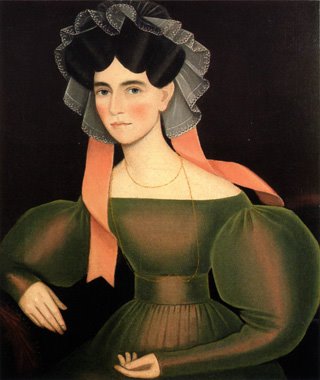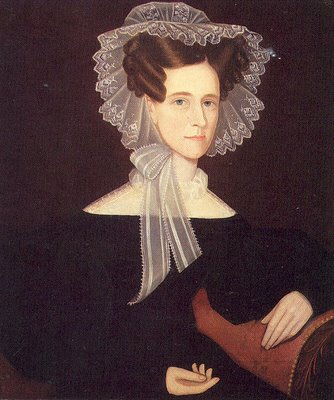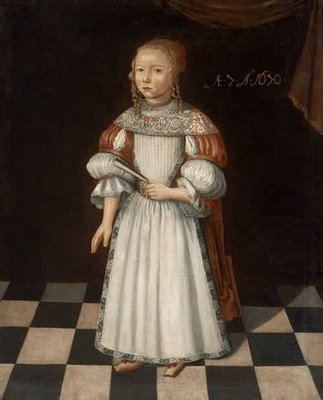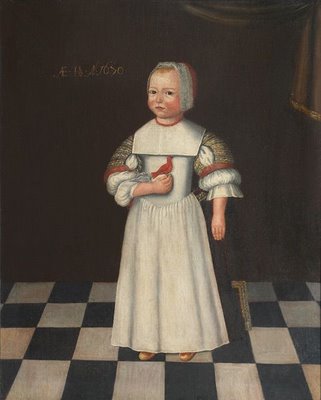



New England's austere people are portrayed with grace and humor by the Border Limner, Ammi Phillips.
Known as: Folk and naïve (primitive) artist
Born: 1788, Colebrook, Connecticut, US
Died: 1865, Massachusetts
Ammi Phillips began his professional career around 1811. He travelled extensively in the New York - Massachusetts - Connecticut border area, and because of this, became known as "Border Limner".
``Miss Bingley,'' said he, ``has given me credit for more than can be. The wisest and the best of men, nay, the wisest and best of their actions, may be rendered ridiculous by a person whose first object in life is a joke.''
``Certainly,'' replied Elizabeth -- ``there are such people, but I hope I am not one of them. I hope I never ridicule what is wise or good. Follies and nonsense, whims and inconsistencies do divert me, I own, and I laugh at them whenever I can. -- But these, I suppose, are precisely what you are without.''
``Perhaps that is not possible for any one. But it has been the study of my life to avoid those weaknesses which often expose a strong understanding to ridicule.''
``Such as vanity and pride.''
``Yes, vanity is a weakness indeed. But pride -- where there is a real superiority of mind, pride will be always under good regulation.''
Elizabeth turned away to hide a smile.
``Your examination of Mr. Darcy is over, I presume,'' said Miss Bingley; -- ``and pray what is the result?''
``I am perfectly convinced by it that Mr. Darcy has no defect. He owns it himself without disguise.''
``No'' -- said Darcy, ``I have made no such pretension. I have faults enough, but they are not, I hope, of understanding. My temper I dare not vouch for. -- It is I believe too little yielding -- certainly too little for the convenience of the world. I cannot forget the follies and vices of others so soon as I ought, nor their offences against myself. My feelings are not puffed about with every attempt to move them. My temper would perhaps be called resentful. -- My good opinion once lost is lost for ever.''
``That is a failing indeed!'' -- cried Elizabeth. ``Implacable resentment is a shade in a character. But you have chosen your fault well. -- I really cannot laugh at it; you are safe from me.''
``There is, I believe, in every disposition a tendency to some particular evil, a natural defect, which not even the best education can overcome.''
``And your defect is a propensity to hate every body.''
``And yours,'' he replied with a smile, ``is wilfully to misunderstand them.''
However, Ammi Phillips is lumped into the folk art category (which I go to interpret as decorative illustration and decorative portraiture) and is in a way pooh poohed as its just a whisker away from primitives (read heaven..the work of the amazing Edward Hicks surfaces immediately).
www.mfa.org says:
The collection of American paintings, over 1600 works, is considered by many to be among the best in the nation. The earliest paintings are anonymous portraits of Robert Gibbs and of Margaret Gibbs, both painted in Boston about 1670.
>Here's a bit more>>
Margaret Gibbs
1670
Freake-Gibbs painter
102.87 x 84.14 cm (40 1/2 x 33 1/8 in.)
Oil on canvas
Classification: Paintings
Accession number: 1995.800
Bequest of Elsie Q. Giltinan
Executed not long after Boston was settled, Margaret Gibbs is one of the finest of the few extant portraits painted by New England artists in the seventeenth century. The artist, who also painted portraits of Margaret's brothers-Robert, age four-and-a-half (MFA, 69.1227) and Henry, age one-and-a-half (Sunrise Museum, Charleston, West Virginia)-is unknown. However, it is thought that he created the likenesses of John Freake and Elizabeth Freake and their baby Mary (Worcester Art Museum) in 1674. He is thus known as the Freake-Gibbs painter and is considered one of the most skilled portraitists of the seventeenth-century colonies, possessing an exceptional sense of design and an admirable feeling for color. Probably trained in provincial England, he painted in a flat style derived from Elizabethan art that emphasized color and pattern.
Margaret Gibbs was the oldest child of Robert Gibbs, an English gentleman who had emigrated from England to Boston in 1658. Robert married Elizabeth Sheafe of Cambridge, Massachusetts, in 1660, and in the same year Elizabeth inherited considerable property from her grandfather. A successful merchant, Robert had their three children's portraits painted in 1670. The depictions of Margaret and her brothers in all their finery are evidence of the materialism and prosperity of the Gibbs family and the remarkable growth of the city of Boston.
In this portrayal of Margaret, the Freake-Gibbs painter has meticulously rendered the seven-year-old's lace, needlework, silver necklace, and red drawstrings and bows. Her sleeves have the single slash allowed by Puritan sumptuary laws. Such finery was only permitted by Massachusetts law if the man of the house possessed either a liberal education or sufficient annual income. Margaret's fan is an indicator of her gender, as children of both sexes were dressed similarly until the age of seven or eight and an attribute was needed to differentiate between images of boys and girls. The pattern on the floor is either black and white tile or, more likely, a wooden floor painted to simulate tiling. This pattern, the dark neutral background, and the inscription of the year and age of the sitter are indications of seventeenth-century Dutch influence on English and subsequently on American art. The period frame of the picture is made from American pine painted black, thus making it probable that it was crafted in New England.
This text was adapted from Davis, et al., MFA Highlights: American Painting (Boston, 2003) available at www.mfashop.com/mfa-publications.html.


